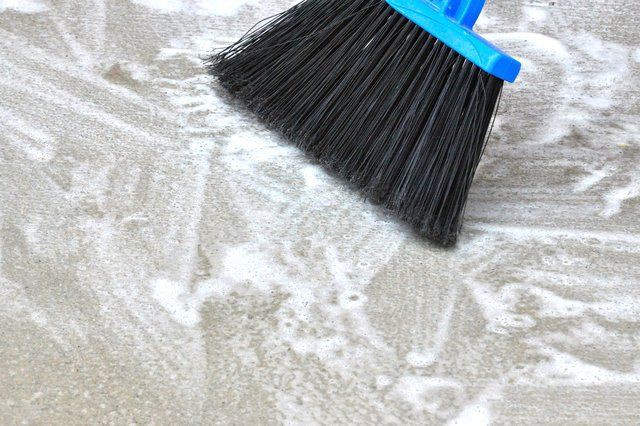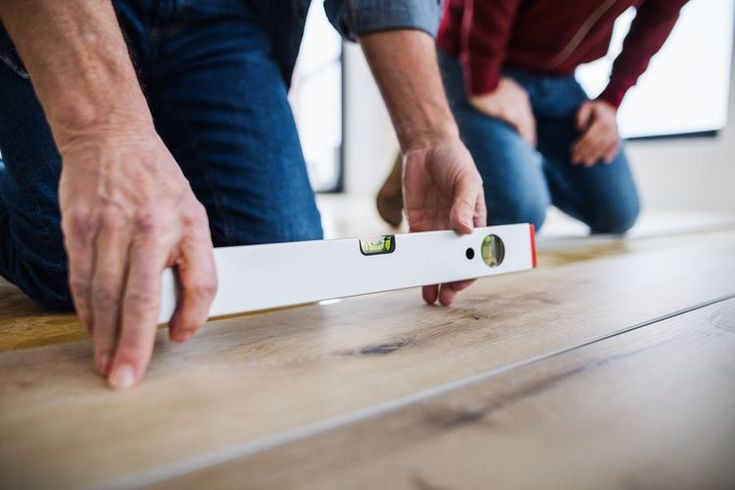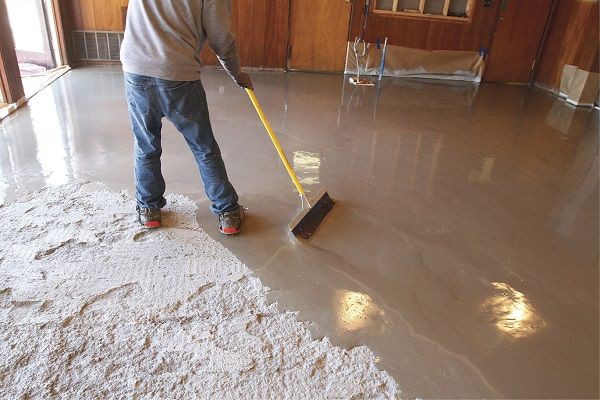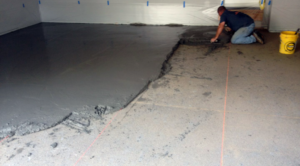The first question you need to address if you want to learn how to level a concrete floor is to ask why the floor is sloppy. Does the floor slope because the concrete was poured wrongly, or is it due to foundation settlement? This question must be answered since the solution will affect how a sloped concrete floor is leveled.

Source: Pinterest
However, experiencing this issue is quite typical. Luckily, solving the problem is relatively easy if you have the correct understanding; you can level the floor all by yourself, even though dealing with it does require some tools and a significant amount of work.
In this article, we will look at the possible causes of this problem and most importantly, how to solve it.
What Are The Causes Of Concrete Floor Sloping?
Foundation Settlement
Floors that are sloping are typically caused by foundation settlement. The home/structure settles unevenly as it descends into a non-load-bearing stratum, applying unequal pressure to the foundation.
Floor Sill, Girder, or Joist Damage or Deterioration
This is one of the reasons for uneven floors. The drawback is that to treat this specific underlying cause, flooring and ceiling boards may need to be removed.
Poor Drainage
This is the most frequent reason for a concrete floor slope. Inadequate drainage, in particular, puts critical components of your home under strains for which they were not intended. For instance, if water pressure builds up on the perimeter foundation, it may crack.
Age Of The House
Most of the time, the aging and deflection of wood are to blame for the slight sloping of flooring in older homes. However, floor sloping in newer homes (say, those within 0 to 5 years) must be thoroughly investigated because in these cases, the slope is more likely to be caused by structural problems.
How To Level A Sloping Concrete Floor?
Now that we have identified possible causes of concrete floor sloping, we can now move on to how to solve the problem. We will extensively focus on the steps to follow to level an uneven concrete floor.
Please Note: Bigger problems like Foundation Settlements require more expertise, time, and effort.
Identify The Cause and Make a Plan
Finding the root of the issue is the first step in fixing a sloping concrete floor. Identify the state of the concrete and know how long and how much money the project will cost. Depending on this, the concrete will either need to be completely replaced or restored in some way.
It is crucial to address the primary cause of the breakdown, measure, and prepare beforehand. If you don’t deal with the root cause, issues will persist even after the concrete floor has been repaired and this can easily destroy the entire endeavor.
Examine The Material Underneath
Always check the type of material beneath the concrete before beginning any repairs. Due to joist deterioration, vacant spaces are discovered beneath concrete floors. If the material beneath the concrete has the necessary bearing capacity and the concrete itself is structurally intact and merely needs resurfacing; then you can pour concrete on top of the existing floor to level the slope.
Clean and Prepare The Concrete Floor

Source: Pinterest
To do this, remove any furniture, items, and appliances. Then thoroughly clean the floor using a dedicated concrete cleaner to get rid of any grease and oil stains as well as dirt and debris.
After that, let the cleaner remain on the concrete for 30 minutes (some cleaning tasks take more time than others, just make sure to read the instructions carefully). You can now use a rag cloth or some similar item to wipe away any liquid and dirt.
The next step is crucial. The surface must be clean for the bonding agent to adhere. Use a metal scraper to remove any remaining flaws, such as chipped or flaking patches, from the concrete and vacuum the surface.
Mark The Uneven Spot(s)

Source: Pinterest
Finding the uneven areas of your concrete floor is the first step in leveling it. You can identify a high point by watching the marbles roll downward, and a low point by watching the marbles stop rolling. A level bar can also be used to check whether your floor is uneven; it can locate and mark off the sloped spots.
Shave off high spots using a concrete grinder by rocking the machine back and forth until the entire area is level. Vacuum up all dust and debris after finishing. Ensure you wear every protective equipment while grinding.
Prepare and Use The Bonding Agent

Source: Pinterest
Follow the directions to dilute the bonding agent with water before using it. Using a nap roller, apply bonding adhesive to the basement floor in a thin layer. The sealant aids in forming a link between the self-leveling compound and the old concrete of the basement floor to produce the new, level floor surface.
Prepare and Pour The Self-Leveling Compound.

Source: Pinterest
The concrete mixture should be well blended using a mixing drill and the appropriate water ratio until it is dense and simple to pour. Pour the mixture on the floor first. Utilizing a squeegee, evenly distribute it. The ideal squeegee to use is one with a long handle.
To level the floor, apply only a 1/4-inch layer of the compound. The self-leveling compound will however sink into the low regions, thus leveling the floor without requiring any more labor on your part. The only thing left to do is wait until it has dried fully. After that, you may always apply more layers if you choose.
Frequently Asked Questions
Can You Pour Self-Leveling Concrete Over Existing Concrete?
Yes. You can pour self-leveling concrete over concrete surfaces. A leveling layer of new concrete can be used to level an existing concrete floor, but first, the old concrete floor needs to be prepared else the fresh concrete will not adhere properly.
What Is The Easiest Way To Level a Concrete Floor?
The simplest method is to apply a self-leveling compound. The substance pours out like thick syrup and then, in as little as an hour, solidifies into a smooth, level surface.
Can You Sand Down Uneven Concrete?
Yes. Use 80-120 grit sandpaper to smooth up little imperfections. Use superfine sandpaper with a grit of 200–400 for a flawless finish and smoothness. If there are significant flaws, a floor grinder or specialized diamond disc is required.


